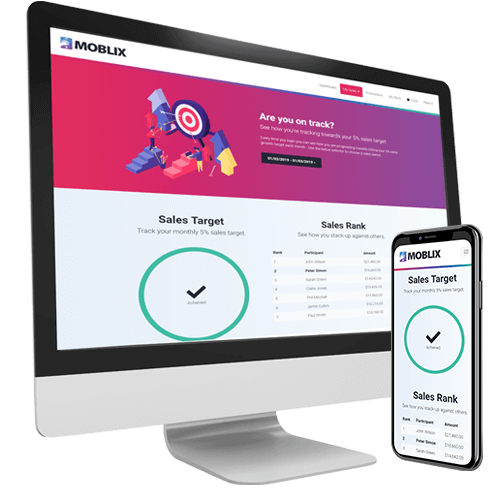How to get sales incentive ideas off the ground & make them unstoppable
This blog will take you through the key areas you have to hit to get your sales incentive ideas off the ground. We won’t bore you with another long list of possible incentive tools, because those are already out there if you need the inspiration.
This blog is about taking your good ideas and making them unstoppable.
Click below to jump to a section:
A great sales incentive idea is only the start
Stop us if you’ve heard this one before. You put together a list of great sales incentive ideas. They’re creative, exciting, and you’re thrilled to present them to your managers.
Everyone on the team agrees they’re great, too. You’re all convinced they would increase sales, motivate sales teams, and everyone would have fun doing it.
But it never quite seems to get implemented. Your incentive ideas bounce around, they’re brought up when you’re under pressure to come up with a new idea. But it’s not what you could have won.
Maybe you see a form of it implemented, a watered-down version. But you never really see them brought to life in a way that maximises their potential.
We get it, we’ve been there. Just about everyone has.
You’re not alone on this one
Many companies run into this issue. Because every organisation has inertia. A resistance to changing processes that comes from the inherent need for a business to keep doing its daily tasks. And for that business to be efficient while those tasks are performed.
It’s not a reason to give up on your sales incentives ideas though. Incentives are a proven method for bringing enthusiasm and performance out of a sales team.
You just need to know how to build the bridge between the good idea you have today, and the scheme you want to see running tomorrow.
1. Do the research and canvas key stakeholders

We don’t need to tell you to do the research and put a plan together. But you need to think about the scope of your research and who you talk to. Not enough people do the internal research that will make an idea easy to implement.
Your ideas need to accommodate the pain points of leadership and any teams affected by your incentive. If your sales incentives are likely to affect a department, you need a conversation with them before putting any grand plans to paper.
This is to:
- Minimise any extra difficulty to them
- Actually alleviate a paint point if possible
Combined, they make it more likely your ideas will gain traction, and reduce the likelihood of a surprise roadblock as you put an idea into action.
Make sure the managers have a voice
The most important person to speak to are the managers of your sales teams. You need their input at the start of your planning stage. Their needs, and their potential objections, are the ones most likely to be a killer roadblock when proposing your ideas. It’s best to answer those objections as soon as possible.
You don’t want a problem to pop-up later on that turns into a reason for leadership to pull the plug and re-focus attention to something else.
The planning process is also an opportunity to put the voice of sales staff into your incentive idea. Not only does hearing their concerns increase the chance they’ll buy into your idea, but you can ask them questions, getting a clear picture of what, in terms of rewards, feels like a good return on investment.
2. Be specific

Set out clear goals about what you want your sales incentive idea to achieve, and for who.
Too many incentive ideas promise to reward outcomes that are washy and broad. Lay out the specific behaviours that will turn into rewarding moments.
Be clear about who you’re trying to motivate, too. Do you need a fire lit under your top guns, the bulk of your staff just getting on with their work, or the low performers? The staff whose behaviour needs to change are the ones that need to be explicitly targeted by your incentive scheme.
Who you need to target will inform what you do to target them.
Focus your ideas on the moments you’re trying to generate and the people from whom you’re trying to draw a reaction.
3. Sell your sizzle

We don’t say this to be rude, but it’s a truth that bears confronting. While this is your project, it’s actually not really about you. It’s not about showing off how clever you are, or how hard you worked, or how great your idea is. It’s about the results, the difference your ideas can make to your company.
This is important to remember when you’re selling an idea internally. No matter how clever, creative and new your ideas are, you need to get your stakeholders invested. And that means selling the sizzle. Focus on communicating the outcomes, the motivation, the possibilities. Not processes.
Don’t dwell on the intricate details of a mechanism for your incentive ideas until you’re asked about them. Let the audience open that door themselves once they’re invested in the outcomes, the advantages are clear to them, and they want to know to achieve them.
This is an investment. Building enthusiasm for the sizzle now will help keep interest in the steak alive later. It’s the difference between a leadership figure asking: “what happened to that incentive idea you had? It sounded really good” and something that sounds complicated being set aside.
4. The right incentive rewards
The carrot works a lot better than the stick for motivating employees. Which means making sure you have the right carrots.
You need to put together a variety of rewards at different value points. Sticking to just one reward value, and just one reward type, will hamstring you.
This is for two reasons:
- Different rewards motivate staff differently
- Your rewards need to scale
We’ll go into more details on scale later, but incentives that last more than a couple of months benefit from being broken into parts. That includes offering smaller rewards along the way, building up to the big one.
The need for variety should speak for itself. What moves the needle for one employee leaves another cold. If staff can’t get excited for their rewards, it’s harder for them to be invested in your sales incentive ideas.
5. Structuring goals for your sales incentive idea

It would be difficult for anyone to give your company advice on how to structure your incentives without proper knowledge of your business.
Every company has their own pattern of quirks, details and difficulties that make one-size-fits-all structures difficult, and frankly a little inadvisable.
However, we can offer you some tenets that should underpin your sales incentive structure when you’re navigating your company’s own problems.
The structure of your sales incentive idea should be:
- Specific – To teams, and the people in them. We’ll cover this in a little more depth later on.
- Measurable – Transparency in your scheme matters, and transparency is easier when you focus on quantifiable elements. Rewarding for ideas that rely on more qualitative elements immediately opens you up to unconscious bias – you quite literally won’t even know you’re doing it. If everyone can see an obvious winner, by terms laid out clearly, it’s much less likely anyone can feel hard done by.
- Fair – Your incentive needs to tread the line between not being unreasonably difficult, but not being so easy an employee would achieve it through their regular work or random chance. This is why it’s important to get which segment of your sales team that needs motivating clear.
- Routine – Organise an incentive idea that’s checked in and updated at constant intervals, with regular feedback to the users and the scheme stakeholders. We’ll go into more detail on how you can make interaction over time easier further into the blog.
Demonstrating care for these areas, and accounting for them in your planning, dramatically increases the chance of success.
6. Give recognition a place

Making sure to integrate employee recognition. As we’ve pointed out many times before, recognition is one of the most impactful things you can do to improve your business.
Your sales incentive idea shouldn’t be any different. By making sure you include recognition as a component of your scheme, you can credibly claim that your incentive idea will help your company improve:
- Employee engagement
- Loyalty
- Motivation
These benefits compound with the benefits of generating more sales and revenue. Be sure to communicate these advantages and work them into your sales incentive ideas.
7. Keep user processes simple

The mechanic that moves employees towards their reward needs to be simple for your sales staff.
We can look to one of our own sales incentive clients for good practice on this. They’re a UK-wide reseller that rewards their customers for loyalty with a sales incentive scheme.
To keep that scheme simple, the end-user has minimal involvement in the crucial processes. All they have to do is submit proof of their purchases through a purpose-built web portal.
Our own incentive system handles all the complicated parts about confirming sales and banking points. The user would never know it was happening; they just have to worry about what kind of reward they want for their efforts.
The focus should always be on providing the user with opportunity, not obligations. This keeps the positive sentiment towards your sales incentive idea high and engagement will follow.
8. Plan touch points

Plan ways to bring users back into the incentive scheme as often as you can without being obtrusive.
Getting something off the ground is a battle, but it’s just part one. Part two is keeping users interested once the launch buzz fades.
We tend to default to common and familiar behaviours, and falling out of the initial excitement of an incentive scheme launch is a problem that needs to be addressed by continuous communication.
We use automated systems that alleviate the need for scheme operators to constantly badger users to come back to a platform.
Instead, we act on user behaviour. Even if it’s the absence of user behaviour.
You will need to set out a plan to communicate with senior leadership too. To keep their engagement with the scheme up. Ideally, you’d offer them a chance to exert their expertise where appropriate to make adjustments that keep engagement high.
9. Timing is everything

As with everything else in life, timing is everything.
Ideally an incentive would be short. Short makes it more likely you’ll get the initial take up, as you’re asking for less from your audience internally. It also more readily gives you results, numbers and feedback to start learning from.
If you’re planning to go long, “chunk” the incentive up into month-long or quarterly bites. While employees are always working towards a longer-term goal, there will also be something for them at shorter intervals.
There are three reasons for this.
First, regularly punctuating a scheme with rewards helps keep the excitement and interaction with that scheme high
Second, some employees might be put off by a goal that seems too far away or not achievable. Breaking into blocks makes it more digestible and shows how a big goal is just a series of smaller goals added up.
Third, when there’s monthly rewards, there’s always something to aim for. Imagine an incentive scheme that’s designed to last six months, but two of your staff happen to have exceptional months right off the bat in the first two months. Staff left to catch-up may feel put off, or discouraged, and disengage from your incentive scheme.
10. Be wary of the cost of doing business

There have been companies that have sold more products, more often, and still lost money.
Essentially, an incentive scheme managed to run a company close to a cash crunch by giving sales staff too much power to set prices.
Giving sales teams some flexibility to bend prices makes lot of sense, too. After all, it’s better to have little bit less profit than lose the sale completely, right? That breathing room might be the difference.
However, the sales staff in these companies were motivated on volume alone. When they managed to wrangle a price from their warehouse to ship products at a certain level, the cost of producing, warehousing, shipping and recording the sale just about overtook the price of the item.
The company appeared to be doing plenty of business, and generating a huge amount of sales. But behind the volume and incentives was a lurking cash crunch that demanded the company spring into action.
Preventing this means talking to your finance department. Or whoever manages your business’ accounts. Alongside them, set hard boundaries on how far, and how often, your sales staff can bend their prices to secure their sales.
Demonstrating that you have considered these issues ahead of time gives your incentive idea much more credibility. In turn, it’s more likely to get off the ground, and unlikely to run into calamitous issues during its operation.
11. Align with the big picture
 Make your incentive idea part of the big picture in your company. Make sure your sales incentive doesn’t just align with, but actively supports, what the wider organisation wants to achieve.
Make your incentive idea part of the big picture in your company. Make sure your sales incentive doesn’t just align with, but actively supports, what the wider organisation wants to achieve.
Not only does this make your scheme more likely to set off the right bells in your audience’s mind, it future-proofs you from.
Alongside the overall direction of your company, consider ethics. We’ve spoken before about how your values can be undermined by an incentive scheme that rewards staff for bending your ethics and values.
12. Plan for just one team
When you want to cash in a good idea and deploy it for another team, you can’t just copy and paste the concept.
The stakeholders, the employees, the teams, their needs. They all change and need room to breathe and adjust a good incentive idea to suit their needs.
Your initial plan should be to deliver your sales incentive idea for one specific sales team and one team only. It greatly increases the chances of success when you focus on the needs of that group.
That’s not to say there won’t be significant overlap if your idea ends up being deployed for other teams. But you’re considerably more likely to enjoy success with an incentive idea when it’s highly specialised.
13. Centralise communication
 Communication is an important part of keeping users interested in a scheme and demonstrating transparency.
Communication is an important part of keeping users interested in a scheme and demonstrating transparency.
Putting everything in one centralised place makes it easy to be transparent, and it makes it easy to offer your incentivised staff a single portal. One idea, one message, one platform means consistency of message across a team.
Make sales incentive ideas a reality
When it comes to launching fresh sales incentive ideas, we’re often the people saying “just get started.” And usually we’d stand behind that. But as you can see, there are quite a few moving parts to a really good incentive scheme.
Because there are stakeholders that need to buy in and be involved, we would advocate doing your homework on sales incentives and building strong foundations before launching. This isn’t a scheme that can be driven and kept alive exclusively by your own determination, cross-department cooperation and buy-in is essential.
Your aim needs to be get past the excitement and delve into a bit of the grit. Yes, dazzle your leadership with the exciting top-level stuff and the prospect of sales and results. But proof your work against the people that will scratch the surface and dig into whether or not your incentive idea is practical. Its execution lives and dies in their confidence.
Earn their buy-in, secure their approval, and make sure your scheme is as close as possible to an airtight workable proposition. Doing this puts you one step closer to pulling off something that hundreds of people in your place talk about but few actually accomplish – having a great idea, knowing it’s worth the effort, and making it happen.
We’re always here
And if you need any advice on your sales incentive ideas themselves, feel free to get in touch. We’re always happy to talk shop.



 Customers that stick around deserve to be shown some love. You can make these schemes informal and simple or do something more robust. It could be a simple stamped card after every purchase, a store card that gives them a discount at the till, or full points-banking system that tracks purchases.
Customers that stick around deserve to be shown some love. You can make these schemes informal and simple or do something more robust. It could be a simple stamped card after every purchase, a store card that gives them a discount at the till, or full points-banking system that tracks purchases. Catch the eye of customers when your product is on the supermarket shelf. Offer a modest reward for every sale, or dangle a really big prize like a holiday or big-ticket electronics. These prizes can be mailed out on purchase confirmation or
Catch the eye of customers when your product is on the supermarket shelf. Offer a modest reward for every sale, or dangle a really big prize like a holiday or big-ticket electronics. These prizes can be mailed out on purchase confirmation or  Up-front prices can be deal-breaker when closing a sale. Offering finance deals to customers with reasonable credit makes it much more likely they’ll entertain a sale.
Up-front prices can be deal-breaker when closing a sale. Offering finance deals to customers with reasonable credit makes it much more likely they’ll entertain a sale. Urgency combats cart abandons. A lot of online retailers notice their users often abandon carts just when they’re about to checkout. This idea offers them a time-sensitive discount on individual products in the basket, or the entire basket, as long as they check out within an hour. Or half an hour. Whatever you deem appropriate.
Urgency combats cart abandons. A lot of online retailers notice their users often abandon carts just when they’re about to checkout. This idea offers them a time-sensitive discount on individual products in the basket, or the entire basket, as long as they check out within an hour. Or half an hour. Whatever you deem appropriate.
 You wanted to know if there was another level of performance that could be eked out of your biggest stars.
You wanted to know if there was another level of performance that could be eked out of your biggest stars. Every workplace has staff that are, at least outwardly, happy with below-average performance. You know they can do more, and you thought incentives would bring that out of them.
Every workplace has staff that are, at least outwardly, happy with below-average performance. You know they can do more, and you thought incentives would bring that out of them. Your plan was to introduce a system that incentivises the bulk of your staff to produce more outstanding performances, more often.
Your plan was to introduce a system that incentivises the bulk of your staff to produce more outstanding performances, more often. Ultimately, middle performers are where you should be focusing the bulk of your incentive efforts. The top workers produce the numbers without your instruction, and the bottom need a different remedy entirely. Your middle achievers make up most of your staff, but they’re the easiest group to forget about because they chug along happily, achieving their targets.
Ultimately, middle performers are where you should be focusing the bulk of your incentive efforts. The top workers produce the numbers without your instruction, and the bottom need a different remedy entirely. Your middle achievers make up most of your staff, but they’re the easiest group to forget about because they chug along happily, achieving their targets.
